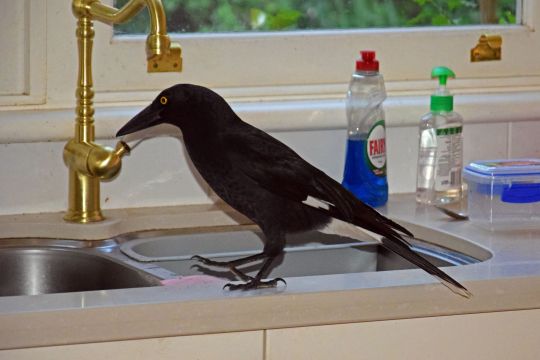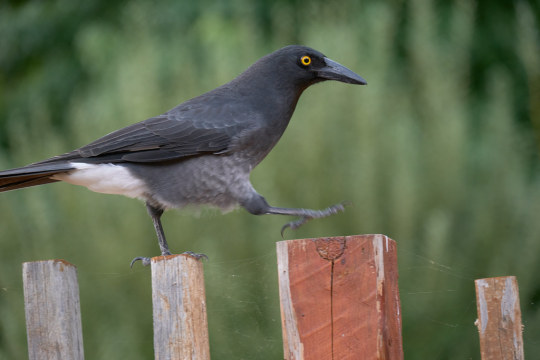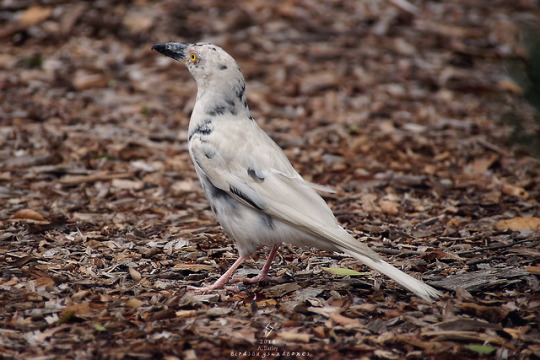#strepera graculina
Explore tagged Tumblr posts
Text

pied currawong (Strepera graculina) by Merryjack
54 notes
·
View notes
Text

Pied currawong (Strepera graculina) portrait in the rain, Skenes Creek, Victoria, Australia.
Photographer: Doug Gimesy
#doug gimesy#photographer#pied currawong#strepera graculina#skenes creek#victoria#australia#animal#bird photography#nature
14 notes
·
View notes
Text
Pied Currawong (Strepera graculina)

"Not only does it look cool, but also makes melodious, almost out of this world sounds!" "I just think it's neat"
This Australian bird is found along the Eastern edge of the continent, and is cousins with the Australian magpie. Unlike magpie, the currawong does the bulk of its foraging in trees, rather than on the ground. While currawong seem crow-like in both appearance and habit, they're only distantly related and instead belong to the "butcherbird" family, Artamidae.
Pied currawong are omnivorous and opportunistic, eating fruit, berries, insects, and smaller vertebrates- typically juvenile birds and bird eggs. They regurgitate pellets that are often clumps of seed and other undigested material, like insect casings.
Sources:
Image source: eBird ( Bruce Wedderburn)
20 notes
·
View notes
Note
Trick or treat, and a very happy cuckootober to you!!
Hello and happy cuckootober! A very large TRICK for you!

Young channel-billed cuckoo (Scythrops novaehollandiae), begging from pied currawong parent (Strepera graculina), by mattwooll, shared under CC BY-NC.
10 notes
·
View notes
Photo

Pied Currawong (Strepera graculina)
© Tony Camilleri
280 notes
·
View notes
Photo

Pied Currawong (Strepera graculina)
© Surfpix.au
161 notes
·
View notes
Photo

Pied Currawong (Strepera graculina)
© I Am birdsaspoetry.com
13 notes
·
View notes
Photo

Pied Currawong (Strepera graculina)
© gardener54
28 notes
·
View notes
Photo

Pied Currawong (Strepera graculina)
© Surfpix.au
11 notes
·
View notes
Video
Pied Currawong by Bear Dale Via Flickr: Pied Currawong Scientific name: Strepera graculina Wikipedia: en.wikipedia.org/wiki/Pied_currawong Ulladulla South Coast of New South Wales Australia Nikon D850 Nikkor AF-S 200-500mm f5.6E ED VR
#Pied#Currawong#Scientific#name:#Strepera#graculina#Ulladulla#South#Coast#New#Wales#Australia#Nikon#D850#Nikkor#AF-S#200-500mm#f5.6E#ED#VR#lake#conjola#NSW#bear#dale#birds
5 notes
·
View notes
Note
Ok ok, top 5 birds you have heard but not seen, and! Top 5 bird calls?
I've only really had two birds that I've herd but not seen, as most birds don't tend to be so allusive as those two are (which I talked about in the previous bird ask), so I think I'll talk about the top 5 bird calls...and see if I can add some audio too 👀 if not then you'll never see this text lol
I should also mention that I picked bird sounds from birds that I've personally heard in my local area! Emperor penguin sounds are like the coolest bird sounds ever and they WOULD be my number one pick, but I don't live in Antarctica LMAO so Australian bird sounds it is!
It was also very hard to chose because i love birdies so much and all their calls can be incredible buttttt i managed it (just barely). also all the bird sounds came from xeno-canto which is an entire website dedicated to recording bird sounds from around the world and everyone should check it out <3 I've used the website many times to accurately identify mysterious birdies and not many people really talk about it as a resource for learning more about birds. also putting the rest of this answer behind a readmore cuz yeah..it got long again. LMAO
#5 Little Corellas
I love these silly little birds. they're very adorable, and when a whole flock flies over your head they can be VERY loud. They often hang out on the grass eating grass seeds and stuff. sometimes they jump and hop along on the ground too! funny birdies <3
#4 Pied Currawong
These guys have a variety of different sounds that they can make, but I chose the sound that I love the most <3 It's just such a nice sounds which itches the brain just right.
#3 Yellow-tailed Black Cockatoo
This is one of the birds that I've only heard, but not seen! I just love their calls, they're soo...idk...great sounding <3 It reminds me a bit of summer. I usually hear them in the distance, and only ever one or two since they're a bit rarer in my local area, but they're around at least!
#2 Australian Magpie
I don't think anyone is surprised by me adding this lol. Their calls are really unique, and over the years me and my mum have heard them make all sorts of cool noises, including mimicking the sounds of a horse! Because yes, they mimic as well as making their own unique sounds <3
#1 Torresian Crow
This might seem like an odd choice for number one....but I just really love crows! The reason I have it at number one is because of the trills they're capable of, which is showcased in the audio alongside their caws.
anyways...that's my fav bird calls! hope you liked em <3
5 notes
·
View notes
Text
Sunday/Monday, 19-20 July
Sunday, 19 July
Another lay-day. We have sort of decided to explore on each alternative day and stay around the van in between. We had quite a few phone calls with the family during the day and felt much more connected, without losing the sense of our somewhat limited freedom in wonderful Gippsland.
We just ‘played’ around the van, looking at photos, sorting them, a few emails - -all the usual, but nothing to report.
Monday, 20 July
What a wonderful day it was! We headed off a tad earlier than usual and roared down the Freeway almost to Morwell before branching off toward Yarram and Port Albert. It was a great drive – a bit of water laying around, but everything was sparkling bright green. We even saw a few birds on the way down, including some we hadn’t seen on this trip to date. And just to mention that the day produced 13 species not previously identified on this trip bringing our count to 67. The 67 includes 2 subspecies added to our Life List – the local Weebill (Smicrorcis brevirostris brevirostris) and the Pied Currawong (Strepera graculina nebulosa).
We did a walk of 6-7 clicks along the Old Port Trail and reached the end of it to find a sign stating that the Trail was closed due to dangerous areas. We hadn’t seen them so went back along the same trail looking (unsuccessfully) for the hazards. We saw a few birds and lots orchids, fungi and flowers. It is interesting how many different species of fungi we have seen in the past couple of months since we have actively looked for them. Fungi seems to be everywhere and in the most amazing, spectacular and enthralling forms. The avian highlight of the walk was a White-bellied Sea-eagle that took off when we reached a point where the trail passed at the very edge of the beach. What a magnificent bird! And I looked to see why it had been standing on the beach and saw a large octopus (the largest I have seen) that it was just starting to devour. I hope it returned to enjoy its meal.
It was a great walk but we got a bit wet a couple of times (not much of an issue given our Aurora waterproof and ice-berg proof jackets), just getting back to the car as the sky opened temporarily.
We ate our lunch and went on to McLoughlin’s Beach. As we approached the town/village/cluster of shacks we saw a sign as we flashed past and went back to see what it said – quite irrelevant, but what did we see in an area of less than 40 square metres right in front of the car? Two male and 4 female Flame Robins, 2 Willy Wagtails, a Grey Shrike-thrush and a Grey Fantail – the male Flame Robins were absolutely spectacular, but I just couldn’t get a photo.
We went on to McLoughlin’s Beach and walked the 1km Boardwalk through the mangroves and a sea of spiky grass to the jetty. Another little surprise awaited – 2 Pacific Gulls, all 3 of the White Egrets (A Great, Little and Plumed/Intermediate), a White-faced Heron, 3 Crested Terns, 2 Pied Oystercatchers and about a dozen Silver Gulls – all crowded within 5 metres of each other. How absolutely wonderful!
That was the end of the walk, but for us, the start of another. We crossed the estuary on the walking trail bridge and walked all the way to the Ninety-mile Beach – perhaps another 3 clicks or so. Right near the end of the bridge we saw a really big kangaroo watching us (and posing for pics) 3-4 metres off the path. He hopped away happily after we had taken our photos, but he was back in exactly the same place when we returned later in the afternoon. We didn’t expect him to be there and didn’t see him until he exploded out of his hidey-hole and just about caused us both to have heart attacks. For a moment, I thought I might die!
It was a really nice walk through the bush and down onto the beach, but it was getting late so we returned to the car and wound our way back home and had a superb dinner. (Boooring – how many superb dinners can we have in a week?)
One of the things we cooked at home to bring with us was a wonderful rich meat loaf, a real favourite of ours and wonderful comfort food. Instead of just heating it and serving it with a few veges, Heather fried it and fried some onions and a few herbs with it and it was sensational – absolutely loved it and we have two more meals of it still in the freezer! We have really loved our fresh veges lately and they seem to be even better down here than in the city – especially the Brussel Sprouts (with butter, pepper, some mint sauce or fresh herbs) – really delicious.
1 note
·
View note
Photo


Leucistic Pied Currawong (Strepera graculina) at the Royal Botanical Gardens Sydney, 2018.
Earlier this year I got wind of a very special, unusual bird at the Gardens. Like any sensible birder, I immediately made plans with friends for a day trip! I was not disappointed - found her within half an hour on site. She was foraging under some of the spectacular trees of the Gardens, feeding her two fledglings, both of whom had typical plumage. I didn’t want to disturb her so didn’t get too close, but I watched her for a while.
This bird is fairly typical for ‘piebald’ presentation of leucism. She still has normal coloured eyes and bill, and if you look closely you’ll see that despite her pink feet, her claws are still dark! Mutations like this are a favorite of mine, and it’s not often I get to see them first hand. For more info and a look at how variable leucism can be, and how easy it is to confuse with albinism, check out this recent discussion.
Shout out to @zoologicallyobsessed for tolerating my enthusiasm during the trip! I was just about out of my mind with glee when I saw this bird.
#ornithology#zoology#leucism#mutations#bbnb makes#bbn talks#i also visited the pollinator display while i was there#photos from that will be soon#natives
764 notes
·
View notes
Photo

Pied currawong. 🔎 (Strepera graculina). ⏳ Conservation Status: Least Concern. Population increasing. 🗺 Endemicity: Australia. 📷 Herberton Range National Park, Queensland. – – #piedcurrawong #currawong #birdsofaustralia #australia #queensland #birdsofinstagram #naturephotography #birds #birdphotography #nature #photography #birdwatching (at Herberton-Range-Nationalpark) https://www.instagram.com/p/Bo3mrALBmzF/?utm_source=ig_tumblr_share&igshid=1srbomjlogk7k
#piedcurrawong#currawong#birdsofaustralia#australia#queensland#birdsofinstagram#naturephotography#birds#birdphotography#nature#photography#birdwatching
2 notes
·
View notes
Photo

Pied Currawong (Strepera graculina), Chichester State Forest, NSW, Australia
Source: http://bit.ly/2lYZWFR
0 notes
Photo

Pied Currawong (Strepera graculina)
© Jono Dashper
43 notes
·
View notes
